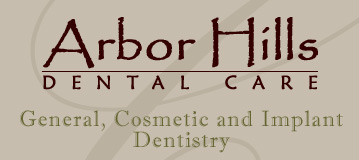What is occlusal disease? Occlusal disease is a pathologic bite that, if undetected and untreated, can damage your teeth, the supporting bone and gums around your teeth, the temporomandibular joints (TMJs), and the jaw muscles you use for chewing. It is responsible for most restorative failures, and it is no less destructive to the teeth and costly than decay or periodontal disease.
Occlusal disease is an often overlooked and sometimes "silent" oral disease that many patients dismiss as "natural aging or wearing" of teeth. In reality, occlusal disease is an unbalanced bite that can at best wear and damage your teeth and at worst, contribute to eventual tooth loss and/or debilitating temporomandibular joint disorder (TMD).
In much the same way a set of tires that are not aligned properly wear faster and do not perform optimally, an unbalanced bite can lead to excessive or abnormally accelerated tooth wear.
In your back teeth, you will notice that there are points (cusps) and valleys (fossae). In an ideal bite, the cusps of your back teeth fit tightly into the fossae of your opposing teeth while the two TMJs seat completely in their sockets. This ideal relationship is rarely found naturally, but when corrected, is the least stressful and least destructive bite relationship for your teeth, bone, gums, TMJs, jaw muscles, and your new dental work.
Other important components of a healthy balanced bite include contacts between the upper front and lower front teeth when the jaw slides forward (for example when biting into a sandwich) and canine contacts during lateral movements (for example when chewing, the canines guide the back teeth into their bite). When the front teeth contact, they protect the back teeth by minimizing the amount of force that the back teeth can create when you chew and/or grind. When the front teeth are not aligned properly or worn, they are unable to provide this protective function, damaging both the front and back teeth (see the photos below), bone, gums, TMJs and jaw muscles. Keep in mind that the human bite is capable of generating forces measuring up to 900 pounds per square inch!
A simple way to demonstrate this "protective" function is by placing your hand on the side of your jaw and clenching fully on your back teeth. Can you feel how forcefully your muscle contracts?
Now, assuming that the upper and lower back teeth can separate from each other when your front teeth are edge-to-edge or canine-to-canine, try clenching with just your front teeth or canines. Can you feel how much less force is created by the muscle?
What are the signs and symptoms? You may have occlusal disease if you have one or more of the following signs and symptoms:
- worn, chipped or cracked teeth
- teeth that sensitive to hot and/or cold
- mobile or loosening teeth
- muscle and/or TMJ pain
- clenching/grinding your teeth
- abfractions or wedge-shaped notches in the teeth at the gumline; when the teeth are stressed by an uneven bite or grinding, they flex causing a microscopic loss of tooth matter at the gumline.
- gum recession
- severe localized bone loss around teeth
- pain in the teeth and/or TMJ when you chew
- headaches and facial muscle pain
- teeth or dental work that fracture or break
How is it treated? During your first visit with us, we will screen for the presence of occlusal disease. If occlusal disease is present, a detailed evaluation of your bite (which includes mounted study models and detailed records of your current condition) may be necessary to properly diagnose the degree of occlusal disease. Many times a gentle and conservative procedure called tooth equilibration (selectively adjusting teeth that are out of alignment) or precisely recontouring specific teeth can create a bite that eliminates stresses on individual teeth and reduces stress on the TMJs and jaw muscles. In more complex cases, several teeth may need to be reshaped and/or restored in order to create the proper balance.
Can occlusal disease be cured? Occlusal disease, like periodontal disease, is often due to chronic conditions that can't be permanently eliminated. However, the good news is that occlusal disease can be controlled so that painful and long-term damage can be eliminated.
I would like to enhance my smile. Should I be evaluated for occlusal disease before starting cosmetic treatment? In much the same way you wouldn't build a beautiful building without proper planning, if you desire to restore, enhance or rejuvenate your smile through cosmetic dentistry, a thorough occlusal disease examination is a necessary first step in order to achieve results that provide maximum health, function, stability and esthetics. Without proper planning, an unbalanced bite can destroy beautiful porcelain veneers and tooth-colored bondings in a very short period of time; creating more instability and breakdown of the teeth, bone, gums, TMJs and jaw muscles.
175 N. Milwaukee Avenue,
Suite 200
Vernon Hills, IL 60061
(847) 955-9500
FAX: (847) 955-9519
Copyright ©2025 Arbor Hills Dental Care, P.C. All Rights Reserved.
 | ||||
 | ||||
Occlusal disease. Note the crooked front teeth, the short worn back teeth, and the chips and unevenly worn edges in the front teeth caused by an unbalanced bite.
A healthy and balanced bite. Note the symmetry of the edges of the teeth, the longer shape of the teeth, the absence of wear or chipping and see how the upper and lower front teeth protect the back teeth when they touch edge to edge.




